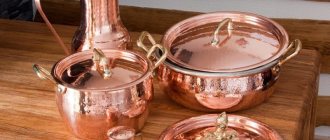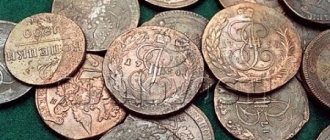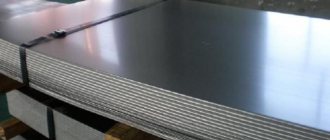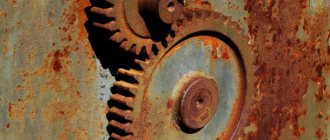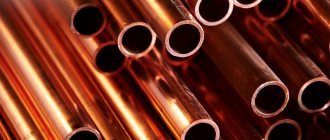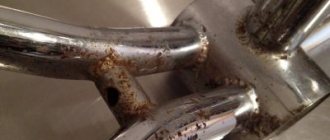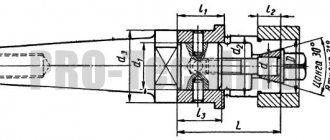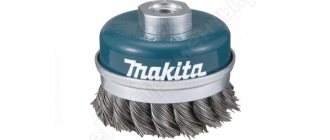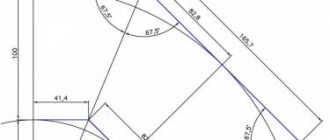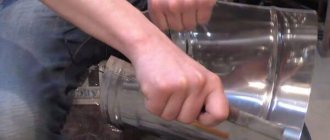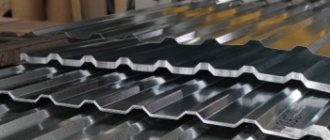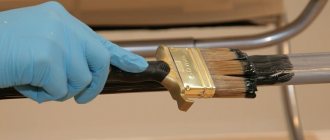What is white coating on galvanized steel?
Sometimes when using galvanized metal products, you may notice the appearance of a white coating on the surface.
The consistency is white and loose.
This is how zinc oxide manifests itself, the only way to deal with it is mechanical removal.
The main problem is that when you remove the oxide with standard means, the coating is severely damaged and can no longer perform its protective functions.
We will try to answer the question of what to do if the galvanized sheet turns white and why this happens.
Correction and prevention
To prevent the formation of “white” rust, it is necessary to take a number of steps related to the handling of finished galvanized products:
- store it in a clean, dry and cool place at a specified temperature;
- do not store products on the ground, use wooden pallets;
- when packing and transporting, use special spacers between products - this will avoid contact of products with each other, and will also allow air to circulate;
- if you lay the products at a slight angle, the water will drain;
- keep products clean.
When placed outdoors, it is necessary to organize storage in maximum accordance with the requirements.
Methods for removing “white” rust are very simple: scrub with a sponge or brush (soft). Additionally, the surface can be treated with acidic solutions: phosphoric, acetic, glycol, citric. The cleaned surface is coated with aluminum paint.
The appearance of “white” rust on a zinc coating exclusively indicates a violation of the handling conditions of the product in the initial period after application of the coating. This is the time when it is most vulnerable to moisture, which is additionally influenced by chlorides and sulfides.
Causes of white plaque
White plaque begins to appear due to the fact that the zinc reacts with air.
Being an active metal, it can quickly become covered with such a layer and this is very scary for customers.
Should we be afraid of such a phenomenon? In most cases, no. The reason is that although the coating itself can spoil the appearance of the product, the zinc carbonate film does not allow oxygen to pass further.
The degree of damage and level of danger depends on what kind of reaction is triggered and how quickly it occurs under normal conditions.
So, if the air is dry and the humidity level does not exceed 70%, the reaction will proceed very slowly.
It will happen much faster in the presence of moisture, as well as in case of improper storage.
When the surface is frequently wet or wet, zinc hydroxide begins to develop, constantly increasing the risk of complete destruction of the protective coating.
Also, the type of galvanizing itself and the features of the product will greatly affect the rate of formation of white rust.
Roofs where air ducts are installed and near dryers
The cause of roof corrosion can be the same effect as in the first example, only here the conditional bitumen will be dust, flour, grain residues and other contaminants that accumulate on roofs near dryers or around air ducts.
Conclusion: Roofs must be periodically cleaned of dirt, but this should be done carefully so as not to damage the fairly thin coating.
Why do rusty spots appear on corrugated sheets?
Corrugated sheets, like any metal product, are exposed to moisture.
It is dangerous because there is gradual destruction and loss of strength. Over time, the sheet may become thin and become completely unusable.
Most manufacturers claim that their materials are protected from rust, but in reality, 4 factors lead to its occurrence:
- Damage to the external polymer coating. When chips and scratches appear on it, in such a place the metal begins to come into contact with air. Oxidation triggers corrosion, which gradually spreads to the entire sheet.
- Poor quality coloring. Defects can often occur in production. Because of this, unpainted areas remain on the surface. When wet and subject to mechanical stress, such places become hotbeds for the spread of corrosion.
- Lack of polymer coating. It is worth understanding that corrugated sheets that have only been galvanized are at risk. It is best to paint the sheets so that they can be used longer in the Russian climate.
- Contact of zinc with air and moisture. This is the answer to the question of why corrugated sheets turn white. Its surface oxidizes when constantly wet and high humidity. In some cases, this problem is not dangerous, but there is a risk that white rust will begin to spread and penetrate deeper and deeper.
Also on the list of common problems are low-quality metal, violation of galvanizing requirements, non-compliance with operating requirements and others.
How to clean the surface?
To achieve a good result, rust removal must combine an integrated approach: mechanical and chemical action.
Just cleaning off the rusty layer is not enough. Chemical exposure prevents the spread of corrosive processes.
In addition, electrochemical effects can be used by passing an electric current through a special solution. This method is used more often in industrial settings, but can also be organized at home, despite the complexity of the organization.
You will find all the most useful and important information about rust removal methods and techniques in this section.
Acids
Let's look at what acids remove rust:
Lemon
Citric acid is a harmless product that will help deal with rust stains on metal, as well as on tiles and other surfaces.
At the preparation stage for cleaning, the acid is diluted with water, preparing a concentrated solution, and applied to the affected areas .
After the composition has been applied for an hour, the acid is washed off with a washcloth. This option is suitable for light stains, but will not cope with serious ones.
Read more about the use of citric acid in the fight against rust here.
Sorrel
Oxalic acid is a chemical substance that exhibits corrosion activity. This drug is effective, but poisonous. Its use must be carried out with high-quality protection, including safety glasses and a respirator. Can be used for advanced cases.
Work order:
- wash the area that needs treatment with a detergent; even laundry soap will do;
- dry the metal;
- Combine 0.3 liters in a separate container. water and 6 tsp. acid powder;
- apply the product with a brush;
- ensure contact of the solution with the metal for 40 minutes;
- clean with a brush;
- rinse under water.
If possible, it is better to clean metal items by immersion in the prepared solution.
Solyanaya
You can remove rust from metal using hydrochloric acid. This method gives a good effect, allowing you to cope with even advanced cases of corrosion.
Work order:
- With a rag soaked in acid, rub the surface with areas of corrosion using polishing, rubbing movements.
- Leave for half an hour.
- Wash off with plenty of water.
You need to wash off the acid especially carefully so that it does not remain on the metal at all, since it can damage the skin of your hands, even in low concentrations. It is necessary to take into account the toxicity of the drug and pay attention to personal protection.
Orthophosphoric
Phosphoric acid is one of the most effective substances for removing corrosion on metal. Due to its ability to react with corrosion products, this drug can cope with even significant damage.
To clean the metal, an acid of 15-20% concentration is used. The time required for exposure is about 5 minutes. After this, the remaining rust is cleaned off with a stiff brush.
Phosphoric acid is included in most rust converters. This article will tell you about the use of phosphoric acid against rust.
Vinegar
Removing rust using vinegar is a simple method that does not require significant investment. But this method will give a good effect only with unstable contamination in domestic conditions, for example, on plumbing.
The best results will be if the rusted metal objects are small and can be completely dipped in vinegar. This method is convenient for bringing bolts, nuts, etc. into proper shape.
It is recommended to use vinegar undiluted. Read more about the cleaning method here.
Soda
Baking soda is an affordable product for combating rusty plaque at home.
To prepare the cleaning composition, you need to make a non-liquid mixture, the consistency of which is like gruel.
Operating procedure:
- Using a sponge, apply the composition to the area of contamination using rubbing movements.
- The mixture is left to act for half an hour.
- Rub the metal again with a sponge or brush.
- Rinse off.
Hydrogen peroxide
Peroxide is a cheap pharmaceutical product used to disinfect wounds. In addition, this drug is actively used to remove dirt from various surfaces, and also helps to cope with rust.
You can use peroxide as a stand-alone product or in combination with sodium salt, which can increase the effect.
Procedure:
- pour 4 tbsp into the prepared container. trisodium phosphate;
- pour in 3 liters of water;
- pour in 50 ml of peroxide very slowly, in small portions;
- Dip rusted tools or other metal objects into the container;
- leave the metal in the solution for half an hour;
- wash off the composition with water.
For large objects, active rubbing of the metal surface with a solution is acceptable. Periodically, several times, every 10 minutes, repeat rubbing.
It is convenient to use peroxide to combat corrosion if it is present in small quantities , for example, on kitchen utensils.
Aluminium foil
Aluminum foil, which is used in the kitchen during food preparation, can be used for an abrasive effect.
To do this you need:
- Cut off a small piece of foil.
- Form this piece into a ball.
- Use this ball to treat rust stains using rubbing movements.
This method can be used to treat small stains, but it is not suitable for eliminating serious corrosion damage. Treatment with foil gives an unstable result.
This method is suitable as a temporary measure , if necessary, to eliminate local traces of rust, for example, on an iron.
After using only aluminum foil without the use of additional products, the result will not last long - no more than a few months.
Cola
Using Coca-Cola for corrosion is a popular cleaning recipe . In order to get a noticeable result, it is necessary to ensure contact of the cola with the metal surface.
If you need to process metal that is fixed at an angle or vertically, you can soak a rag with it and apply it to the desired areas.
Depending on the extent of the corrosion processes, exposure should last from several hours to a day. After this, the surface is brushed and washed off with water.
The effectiveness of the recipe is due to the phosphoric acid contained in cola. Read more about this method of cleaning surfaces from rust in this article.
Battery
Even a regular battery can be used to remove rust. To carry out the work, you need to prepare tools and consumables.
You will need:
salt batteries with a zinc body;- rubber gloves;
- blade;
- insulating tape (or rubber band);
- baking soda;
- the wire;
- sponges;
- car battery;
- electric clothespin (optional);
- orthophosphoric acid.
You can check that the battery is a salt battery with a zinc case using a magnet - it should not be magnetized.
Work order:
- Use a razor blade to remove the wrapping from the battery.
- Wind the wire around the body, securing it with electrical tape.
- Attach the sponge with electrical tape to the end marked “-”.
- Remove rust from the metal that will be processed.
- Soak the sponge in phosphoric acid.
- The battery wire is connected to the “+” side of the car battery. This can be done conveniently using an electric clothespin.
- Burning off rust is carried out by pressing the end part of the battery, which has a cotton pad on it. Hissing and the appearance of foam should indicate that the process is proceeding correctly.
- During the processing process, the cotton swab burns out and must be replaced. If a large area of metal is to be processed, then the battery will also have to be changed.
During the processing process, you cannot linger in one place. It is necessary to drive over the source of corrosion, ensuring the removal of rust and the transfer of zinc to the surface.
After galvanizing, the acid must be removed. Soda is used for this. A concentrated aqueous solution is prepared from it, which is used to wipe the surface.
After this treatment, the metal will be protected and will not rot. Even if significant damage has already been caused by corrosion, further spread of the process will be stopped .
You can learn more about this rust removal method from this article.
How to remove white plaque
If you see that a white layer has appeared on the surface, get rid of it as soon as possible.
The algorithm for dealing with this phenomenon looks like this:
- The surface is thoroughly dried. Create working conditions with low humidity levels. The surface must dry evenly; moisture will harm the process.
- Choosing a method of elimination. When selecting a suitable technology, you should focus on the area where plaque is localized and its quantity. If the problem has not yet manifested itself so strongly, and only covers a small area, take the metal product out into the fresh air. In this case, the plaque will have to be dealt with using oxygen. Indoors, place the part in a dry space, and then clean it with nylon or a stiff brush. The main thing is to work carefully.
- Remove the coating and apply a new one. This option is suitable only for the case when a large area is affected by plaque. In such a situation, only re-galvanization will extend the service life. To remove zinc, use a wire or nylon brush.
The most dangerous case is when the white color turns black. In this case, it will not be possible to clean the affected area; you need to re-galvanize it as soon as possible.
How should you not wash your trailer or trailer?
Please note: not all parts of towed vehicles can be cleaned of dirt with ordinary water.
- Do not try to wash the bearing bushings with water.
- Do not hose down the hitch.
- Be careful when washing side lights and turn signals, because the headlights are not installed airtight; do not allow water to come into contact with electrical wires.
- Also protect electrical equipment in the so-called “bulb”, which covers the socket with wires on the trailer tongue.
- It is not allowed to wash a trailer platform frozen in severe frost with hot water.
- Never scrub galvanized or varnished surfaces with hard metal brushes or scourers.
When washing and cleaning the trailer, pay attention to the general technical condition of the vehicle, check whether the surfaces of the body, bottom, drawbar, and other structural elements are damaged.
If you notice scratches somewhere, carefully clean these places, dry them and cover them with self-adhesive film. You can also cover the damaged areas with silicone aerosol, which will create a film on the surface that protects the metal from moisture. This method will help protect the vehicle from corrosion until it arrives at a service station, where quality repairs will be made.
Finally, it remains to add that in addition to regular cleaning and washing, all vehicles and trailers in particular require timely renewal of lubricant in certain structural components. For example, you need to regularly lubricate the rods in the overrun brake, apply grease to the towbar ball and other parts.
Regular trailer maintenance, lubrication and cleaning are a guarantee of the longevity of your vehicle.
Galvanized steel is steel coated with zinc, which protects the metal from corrosion and increases the wear resistance and durability of the steel. Galvanized steel is often produced as sheet metal and is used to make downspouts, car doors, and convertible car roofs. Although galvanized steel is quite resistant to rust, it can get dirty and needs to be handled with care. To take care of a galvanized steel item and ensure it has a long life and looks good, it needs to be cleaned regularly.
Order galvanizing from Tochinvest Zinc
will perform re-galvanization after removing plaque on the surface.
There are 3 reasons in favor of contacting the company:
- The equipment used is from the German-Austrian company KVK KOERNER and the Czech company EKOMOR. This increases the level of galvanization.
- Compliance with technology. The process meets the requirements of GOST 9.307-89.
- Speed of work. Three galvanizing lines allow you to work even with large batches.
To get answers to your questions and order the company’s services, leave a request on the website or call.
Return to articles Share article
